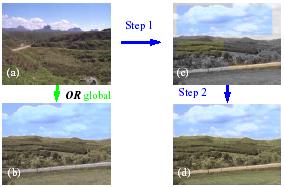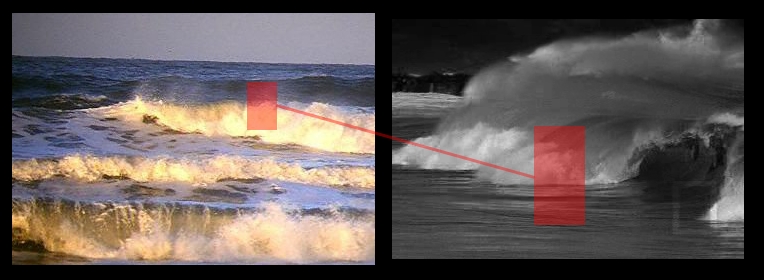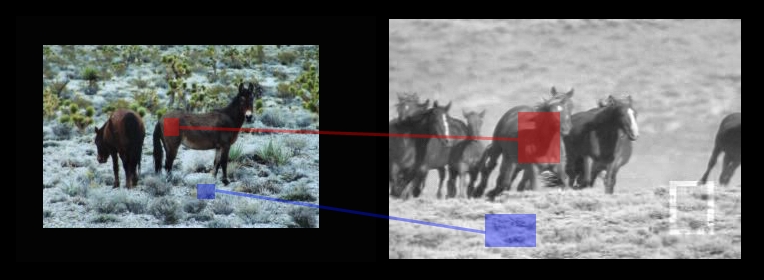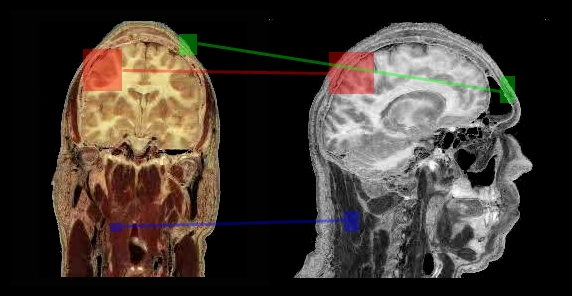Transferring Color To Greyscale Images
Tomihisa Welsh, Michael Ashikhmin, Klaus Mueller

Abstract
We introduce a general technique for “colorizing” greyscale images by transferring
color between a source, color image and a destination, greyscale image.
Although the general problem of adding chromatic values to a greyscale
image has no exact, objective solution, the current approach attempts to
provide a method to help minimize the amount of human labor required for
this task. Rather than choosing RGB colors from a palette to color
individual components, we transfer the entire color “mood” from the source
to the target image by matching luminance and texture information between
the images. We choose to transfer only chromaticity information and
retain the original luminance values of the target image. The procedure
is further enhanced by allowing the user to match areas of the two images
with rectangular swatches. We show that this simple technique can
be successfully applied to a variety of images and video provided that
texture and luminance are sufficiently distinct. The images we have
generated demonstrate the potential and utility of our technique in a diverse
set of application domains.
Full Paper to appear in SIGGRAPH
2002 (3.9 Mb)
Method
Our concept of transferring color from one image to another is inspired
by work by Reinhard et al. [CG&A Sept/Oct 2001] in which color is transferred
between two color images. In their work, colors from a source image are
transferred to a second colored image using a simple but surprisingly successful
procedure. Since both the source and target spaces have color, matching
involves 3 channels. However, greyscale images only contain one color
channel (luminance), so we can only match values between the luminance
channel of the source and target images. We use neighborhood statistics
to help guide the matching process. Once the best match is found,
we transfer only color value for that pixel and retain the original luminance
value of the target pixel. In difficult cases, a few swatches can
be used to aid the matching process between the source and the target image.
After color is transferred between the source and the target swatches,
the final colors are assigned to each pixel in the greyscale image by matching
each greyscale image pixel to a pixel in the target swatches using the
L2 distance metric. Thus, each pixel match is determined by matching it
only to other pixels within the same image. Figure 2 shows the basic
idea.
 |
Figure 2: The two variations of the algorithm. (a) Source color image.
(b) Result of basic, global algorithm applied (no swatches). (c) Greyscale
image with swatch colors transferred from Figure 2a. (d) Result using swatches. |
Results
Figure 3:






Please Note:
Figure 1: Source courtesy (c) Ian Britton - FreeFoto.com
Figure 3a: Images courtesy of Adam Superchi and Philip Greenspun.
Figure 3c: The Ansel Adams photograph was orginally commissioned by
the Department of the Interior. The source image is courtesy of Paul
Kienitz.
Figure 3f: The SEM photograph is courtesy of Scott Chumbley.
Video
For all three movie clips, we used swatches to colorize a single
frame in the movie sequence. Then the colorized target swatch for
the frame was used as the source samples for all other frames in the movie
sequence. Note, the original target movie clips were color but turned
to greyscale for demonstration purposes.
Waves

View MPEG Movie
Video courtesy of National Geographic.
Horses

View MPEG video clip
Video courtesy of National Geographic.
Brain Volume
This brain volume was originally from the Visible Human dataset.
The movie was obtained at http://www.cs.adelaide.edu.au.

View MPEG video clip


![]()